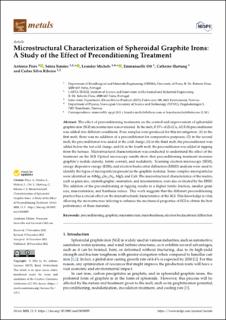| dc.description.abstract | The effect of preconditioning treatments on the control and improvement of spheroidal graphite iron (SGI) microstructure was evaluated. In the melt, 0.15% of Zr-(Ca, Al) FeSi preconditioner was added into different conditions. Four samples were produced for this investigation: (1) in the first melt, there was no addition of a preconditioner for comparative purposes; (2) in the second melt, the preconditioner was added at the cold charge; (3) in the third melt, the preconditioner was added before the last cold charge; and (4) in the fourth melt, the preconditioner was added at tapping from the furnace. Microstructural characterization was conducted to understand the effect of the treatment on the SGI. Optical microscopy results show that preconditioning treatment increases graphite’s nodule density, ferrite content, and nodularity. Scanning electron microscopy (SEM), energy dispersive energy (EDS), and electron backscatter diffraction (EBSD) analysis were used to identify the types of microparticles present in the graphite nodules. Some complex microparticles were identified as AlMg2.5Si2.5N6, MgS, and CaS. The microstructural characteristics of the matrix, such as grain size, crystallographic orientation, and misorientation, were also evaluated by the EBSD. The addition of the preconditioning at tapping results in a higher ferrite fraction, smaller grain size, misorientation, and hardness values. This work suggests that the different preconditioning practice has a crucial effect on the microstructural characteristics of the SGI. This knowledge is vital, allowing the microstructure tailoring to enhance the mechanical properties of SGI to obtain the best performance of these materials. | en_US |

